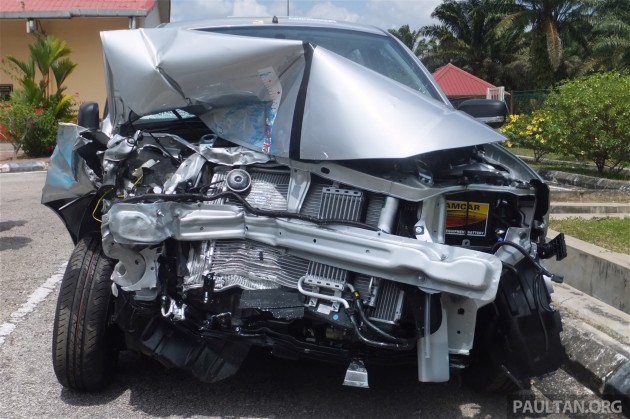Women more likely to be seriously injuried in crashes, attributed to vehicle chosen by each gender: report
Women have been found to be more likely to be seriously injured in car crashes, though their increased exposure to risk isn’t so much due to physical differences, but rather due to the types of vehicles chosen as well as the circumstances of the incidents, according to the Insurance Institute for Highway Safety (IIHS).
The institute has found that although men are involved in more fatal crashes than women, the latter are 20-28% more likely to be killed and 37-73% more likely to be seriously injured on a per-crash basis, after adjustment for speed and other factors.
When the comparison is limited to similar crashes, however, the discrepancies were found to have “mostly disappeared”, and the improvements in vehicles’ crashworthiness benefited both male and female occupants more or less equally, it found. These point toward the choice of vehicle as a factor, according to the report.
“The numbers indicate that women more often drive smaller, lighter cars and that they’re more likely than men to be driving the struck vehicle in side-impact and front-into-rear crashes. Once you account for that, the difference in the odds of most injuries narrows dramatically,” said author of the study and IIHS vice president of vehicle research Jessica Jermakian.
The discrepancy in the risk of injury for men and women has prompted calls for new crash test dummies to better reflect how women’s bodies react to the forces involved in a car crash, as well as other changes to crash testing programmes, and the new study seeks to learn discover more about the issue and to learn what changes to its vehicle testing programme should be made, the IIHS wrote in its report.
The data for this report was drawn from police-reported tow-away front and side crashes between 1998 and 2015, from which the injuries for the men and women involved were analysed.
In frontal crashes in comparison to men, women were found to be three times as likely to experience moderate injury such as a broken bone or concussion, and twice as likely to suffer serious injuries such as a collapsed lung or traumatic brain injury, said the report.
In side crashes, both men and women recorded odds that were ‘about equal’ for moderate injury, while women were about 50% more likely to be seriously injured in side crashes. The analysis was repeated with a limited set of ‘compatible’ front crashes in order to determine how much of the discrepancy was due to the physical differences between men and women.


This subset was restricted to single-vehicle crashes, as well as two-vehicle crashes in which the vehicles were similar in size and weight, or the crash configuration was such that the size and weight differences would not have played a major role in the outcomes. To further reduce the differences among crashes, only those with front airbag deployment was used.
This limiting of samples to compatible front crashes reduced the male-female outcome disparity considerably, said the IIHS report, however women were still found to be twice as likely to be moderately injured, and ‘a bit more likely’ to be sustain serious injuries.
A further analysis found that vehicles which achieved good ratings from the IIHS moderate overlap front and side crash tests also resulted in lower odds for most injuries ‘more or less equally’ for both males and females. The compatible front crashes found that a good rating in the moderate frontal overlap test gave greater benefit for women except for odds of leg injuries, in which case the benefits were evenly split.
In findings for side impact crash tests, a vehicle that scored a good rating was found to benefit men and women ‘about equally’ where likelihood of moderate injuries were concerned, however vehicles found to be crashworthy in this manner were found to be more beneficial to women in the odds against serious injuries.


These findings are in line with previous research that the risk of serious and fatal injury have reduced more for women than for men, as vehicles have become safer. That said, one explanation for the higher injury rates recorded for women could be the choice of vehicle, said the IIHS.
Men and women were found to have experienced crashes in minivans and SUVs in about equal proportions, however around 70% of women crashed in cars, compared to 60% of men in the same vehicle type. More than 20% of men were found to have crashed in pick-up trucks compared to less than 5% of women, and men were also found to experience crashes in heavier vehicles within the same vehicle classes, which offer more protection.
A separate analysis of data from the United States’ federal Fatality Analysis Reporting System has also found that within two-vehicle front-to-rear and front-to-side crashes, men are more likely to be driving the striking vehicle. Because the driver of the striking vehicle is at lower risk of injury than the driver of the vehicle being struck, this could also account for some difference in outcomes for men and women, the report said.
That said, the overall improvement in vehicle safety benefits both men and women. “The good news is that changes like strengthening the occupant compartment and improving seat belts and airbags have helped protect both men and women. Homing in on the risk disparities that still exist in compatible crashes gives us a great opportunity to make further gains,” Jermakian said.
The post Women more likely to be seriously injuried in crashes, attributed to vehicle chosen by each gender: report appeared first on Paul Tan's Automotive News.
from Paul Tan's Automotive News
Read The Rest:paultan...




Post a Comment